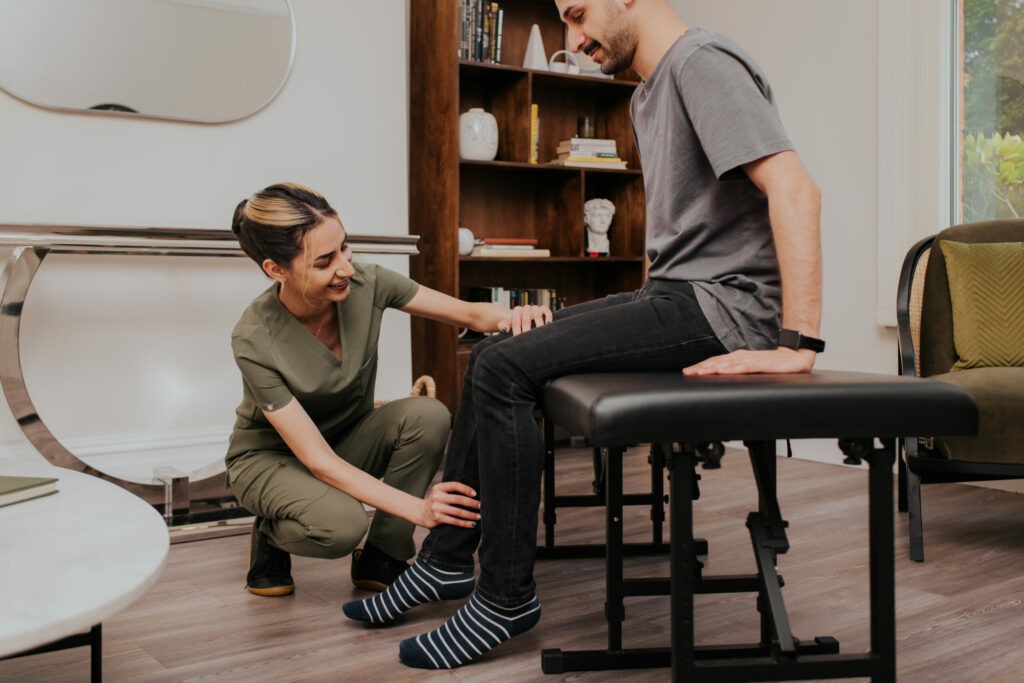Knee Pain
Knee

Common causes of knee pain include:
Patellofemoral Pain Syndrome
This is an umbrella term that describes pain at the front of the knee, and/or around the joint between your kneecap and the thigh bone (i.e., patellofemoral joint). Symptoms often happens during activities such as squatting, running, going downstair and sitting for too long.
Common symptoms include:
- Pain at the front of the knee or behind the kneecap
- Worsening pain during activities
- Stiffness and reduced mobility
- Swelling
The causes of patellofemoral pain are multifactorial including:
- Overuse: In many cases vigorous activities such as jogging, and squatting can put repeated stress on the knee. It can also be caused by sudden change in activities such as increasing the number of days you’re training or the intensity/duration of the activity.
- Anatomical malalignment: When the knee bends and straightens the muscles at the front of the thigh known as quadriceps help to keep the kneecap in position. Weak or imbalanced quadriceps can cause abnormal tracking of the kneecap resulting in patellofemoral pain. Another factor could be the misalignment of the legs causing the kneecap to shift too far towards the outside or inside of the leg (i.e., bowlegs and knock-knee.)
- Other factors include using improper training technique and change in footwear
In most cases, patellofemoral pain can be treated using conservative options including:
- Activity modification such as retraining proper techniques, changing training routine or stitching to low impact activities
- Physical therapy to enhance flexibility, correcting gait and improving lower extremity biomechanics
- Orthotic can help align and stabilize your ankle and taking stress off of the legs.
Surgical treatment may be considered when there is no improvement after strict adherence to the conservative therapy for more than 6 months.
Sprained/Strained Knee Ligament
- Swelling
- Buckling
- Weakness
- Bruising
- Sudden painful popping and stiffness
Torn Meniscus
Meniscus plays a vital role in knee stability, shock absorption and force transmission in the knee while walking and other activities. Research suggested that meniscal injury leads to early onset osteoarthritis. In fact, meniscal injury is one of the most common sports injuries and thus its prompt diagnosis and appropriate management is essential.
Meniscal tear can cause a range of symptoms including:
- Pain
- Swelling
- Catching/locking
- Giving away
Patellar tendonitis (Jumper’s knee)
Patellar tendinitis is the inflammation of the tendon connecting your kneecap to the shinbone. Jumper’s knee is caused by overuse of the knee joint such as frequent jumping in sports like basketball and volleyball.
Common symptoms of jumper’s knee include:
- Pain with jumping, running or walking
- Pain when bending or straightening your knee
- Tenderness below your kneecap
Most cases of jumper’s knee will resolve with non-surgical management. Surgical treatment remains the last resort for cases unresponsive to conservative treatment. It is usually indicated in case of partial tendon tear where pain continues during rest and activities.
Osteoarthritis (OA)
Osteoarthritis so called “wear-and-tear-arthritis” is the most common form of joint arthritis and cause of disability in the UK. It can occur in any joint in the body, bust most often develops in weight-bearing joint such as hip and knee.
Approximately 18% of adults over 45 years of age in the UK has knee OA. While aging is the major risk factor for developing knee OA, there are several factors that can increase the risk of developing knee OA at younger age including:
- Weight: Excess weight increases joint loading, resulting in deleterious effects on the weight-bearing joints like the knees.
- Genetic predisposition: genetic mutations might make a person more likely to develop osteoarthritis of the hip.
- Gender: Women are more likely to develop osteoarthritis of the knees
- Repetitive stress injuries: People with certain occupations that involves activities such as kneeling, squatting and lifting heavy weights are more likely to develop knee OA due to constant stress in the knee joints.
The most common symptoms of Knee OA include:
- Pain around the knee joint
- Decreased mobility
- Grinding or popping sound
- Swelling, locking, and giving away
Treatment designed for knee OA should aim to relieve pain, improve function and quality of life. Research revealed that osteopathic treatment and exercise treatment together improve function, relieve pain, reduce the need for total knee replacement and steroid injections. Other Non-surgical options include:
- Modifying intensity of the activities performed
- Strengthening exercises
- Pharmaceutical treatment such as NSAIDs
- Injection of corticosteroid or hyaluronic acid into the knees
According to the National Institute for Health and Care Excellence (NICE) guidelines, when a person with osteoarthritis has severe pain that is significantly affecting their life, and other treatments have been explored, they may be referred to an orthopaedic surgeon for consideration of joint surgery.
What Our Clients Say

I got in touch with osteoandspinal after my second knee surgery as I was concerned about my recovery. After my initial consultation, Mahsa explained the issue and laid out a thorough plan for rehabilitating my knee. Following the recommended exercises and after a few adjustments, I’m already feeling stronger and more confident. I am very pleased with the results and would highly recommend osteoandspinal clinic.
Aryan R

I can’t recommend this place enough! I visited osteoandspinal during my pregnancy when I developed a severe back pain. Mahsa made me feel comfortable and at ease by explaining all aspects of the treatment. Over the next couple of visits, she managed to reduce the pain through adjustments and acupuncture.
Sophia O
Ready To Book?
If you would like to arrange an appointment you can book online by clicking below. Alternatively you can get in touch with us on 07464 637437 or reception@osteoandspinal.co.uk
